(work in progress)
Map locating Falkland Islands to South America
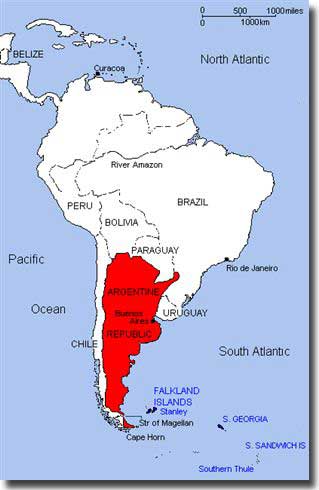 |
The Falkland Islands.Where are they?
They sit in the South Atlantic, 8,000 miles away from Britain, about 2/3 the size of Wales, and 300 miles east of the Straits of Magellan.
Population.
The population is less than 2,000 with half that number residing in the capital Stanley on the east coast of East Falkland, the people are mostly of British extraction engaged in farming some 600,000 sheep.
Argentina.
This quite large country covers 2,300 miles stretching from Bolivia in the north to almost Cape Horn in the south, in contrast to the tiny Falklands has a large population in excess of 28 million. With their Spanish association, and becoming independent from Spain in 1816, this country has long claimed sovereignty over the Falkland Island group, which they call the Islas Malvinas.
Troubled History of the Falkland Group of Islands.
These remote islands were first sighted by Europeans back as far as 1502 by Italians, then in 1520 by Magellan. The first British sighting here came in 1592, when Captain Davis sailed into the area, but it was 1690 before any landing was made, when Captain John Strong named Falkland Sound after Lord Falkland of the Admiralty. Through the Treaty of Utrecht of 1713, Spain controlled the islands, but the French established a settlement at Port Louis in 1764.
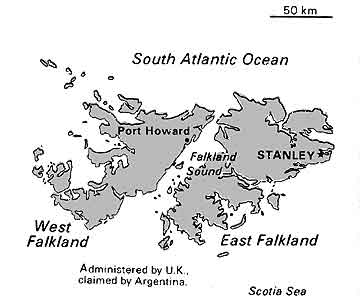 Now it was the turn of the British, who in 1766 set up a British Colony on Saunders Island at Port Egmont off West Falkland Island, now they tried to eject the French from Port Louis, but they had in turn handed over this area to the Spanish who renamed it Puerto Soledad.
Now it was the turn of the British, who in 1766 set up a British Colony on Saunders Island at Port Egmont off West Falkland Island, now they tried to eject the French from Port Louis, but they had in turn handed over this area to the Spanish who renamed it Puerto Soledad.
Now in 1770, the British are forced to leave Port Egmont, but Spain had a change of heart in the following year allowing the British to return. Until the 19th. Century these Islands remained as the Spanish Colony of Islas Malvinas.
As noted earlier, Argentina gaining independence from Spain in 1816 claimed this off shore territory as legitimately belonging to them.
Britain colonises Falklands.
Not withstanding any claims by Argentina, Britain went ahead in 1842, declaring a Colonial Administration over the Falklands, which at that stage had strategic usefulness because of their proximity to Magellan Straits with its passage from the South Atlantic Ocean into the Pacific Ocean via Cape Horn. In 1845 the town of Stanley was established, and Britain has remained ever since.
United Nations Resolution 2065.
In 1965, the UN with their Resolution 2065 declared the Falklands/ Malvinas as a colonial problem, and called upon both Britain and Argentina to peacefully sort it out. Talks between these two countries went on, and off, and on again, over the next 17 years, without any resolution being reached.
In 1976, Argentina set up a scientific group on South Thule, and in 1982 they were ready to land forces in South Georgia, and looked like invading the Falklands.
Invasion.
Now Argentina acted, their forces landed at South Georgia, and on the 2nd. of April in 1982 they invaded the Falklands, captured Stanley, forcing the British Governor to surrender.
Diplomacy.
Britain sought to bring pressure to bear on Argentina through the United Nations, and in the earlier stages of this dispute President Ronald Reagan sought to stay neutral, although he did send General Haig off on a shuttle diplomacy mission. The EEC proclaimed sanctions against Argentina, but the end of April the US had come out on the side of Britain.
Margaret Thatcher acts.
Never one to hold back, it did not take the Iron Lady, Margaret Thatcher, the British Prime Minister long to act, she soon ordered a Task Force of some 30, 000 Service men and women in a large Naval and invasion force, backed up by the Royal Air Force to be on its way to the South Atlantic to retrieve the situation in the Falklands.
South Georgia recovered.
On the 25th. of April South Georgia was recovered to again be under British control.
Falkland attack.
On the 1st. of May, the British Carrier Battle Group attacked the Falklands, whilst Argentinean Super Etendard aircraft armed with Exocet missiles attacked the British Task Force to sink the Destroyer HMS Sheffield and the Aircraft/ Helo support ship Atlantic Conveyor.
British Nuclear powered Submarine HMS Conqueror, sinks Argentine Cruiser General Belgrano on May 2nd. 1982
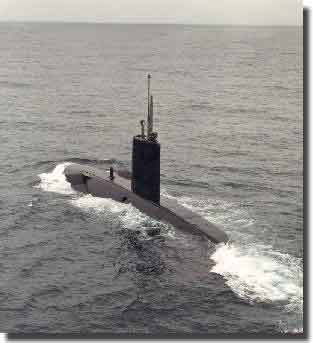 |
Argentinean Cruiser General Belgrano Sunk.
Britain had drawn a Total Exclusion Zone around the Falkland Islands group, and threatened to destroy both enemy ships and aircraft entering into the TEZ. On the 2nd. of May, the British Atomic submarine
Conqueror came upon the Argentinan Cruiser
General Belgrano, ( this ship was of course the ex USS
Phoenix, which was alongside at Pearl Harbor when the Japanese attacked on the 7th. of December 1941, she escaped to sea, she had a distinguished career in the Pacific War, often working with my ship HMAS
Shropshire.)
Although the General Belgrano was actually outside the TEZ, it was considered that she posed a threat to the British Carrier group, and orders were given to sink the Argentina Cruiser, two conventional torpedoes soon sunk her with a loss of life of 300 enemy sailors.
By Mid June the war was all over.
By the middle of June it was all over, the British forces absolutely overwhelming those of Argentina, and on the 15th. of June the enemy surrendered.
Losses.
HMS Ardent mortally damaged, with 22 killed and another 30 wounded
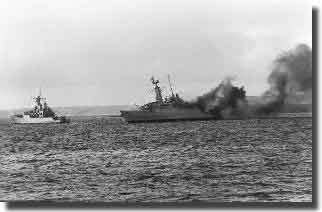 |
In addition to the two British ships already mentioned, two frigates,
Antelope and
Ardent, were sunk by bombs, and the destroyer
Coventry suffered the same fate. Another 5 British warships were also severely damaged. About 28 British aircraft were lost including Wessex and Sea King helicopters, and Harrier jump jets. The losses of personnel on the British side ran to about 1,000. One needs to ask, Were such losses justified to regain some remote South Atlantic Islands, or was it all about PRIDE?
Argentina.
They sustained aircraft losses of about 100, and left behind a mass of war material, including artillery, armoured cars, missile and radar systems, aircraft and helicopters. The Fleet transport Isla De Los Estados was lost and the submarine Santa Fe disabled. Their invasion of the Falklands had proved to be a disaster.
British Task Force comes home.
Argentine aircraft Etendard, with Exocet missiles they sink 2 British warships
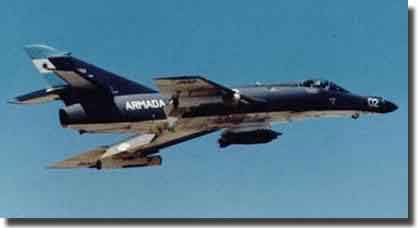 |
The British Task Force sailed home to a heroes welcome, greeted by a triumphant Government led by the Prime Minister Margaret Thatcher, absolutely delighted with the success of her Armed Forces. The Carrier HMS
Invincible after a claimed record of 166 days at sea, steamed into Portsmouth Harbour, to be greeted by Her Majesty Queen Elizabeth the Second. The troops were home again, except for the many who had died, most of whom lie buried in those distant islands thousands of miles from home, and their relatives.
Fortress Falklands.
The British Government committed their Defence Policy to what they named Fortress Falklands. The airfield was extended to be able to take Hercules Transport aircraft, whilst the airfield at Stanley could now handle Phantom Fighters. By 1985, Mount Pleasant air field was completed to handle wide bodied long range jet transports capable of reinforcing the Falklands at very short notice.
Back to normal.
For the residents of these remote islands the excitement was over, their days in the spotlight of the world media at an end, it was back to the mundane routine of trying to carve out a living here, still under the guardianship of Great Britain
(to be continued)
Pictures to come:
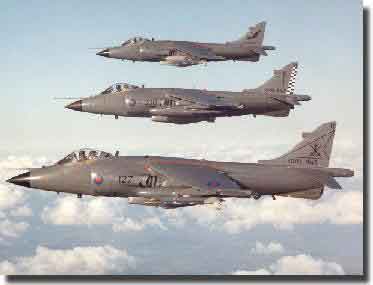
Fleet Air Arm Sea Harriers in action in Falklands War
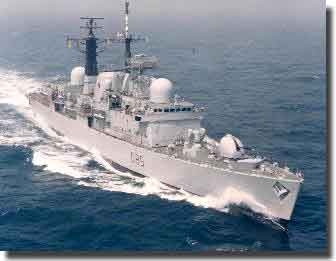
Destroyer HMS Glasgow
February 11, 2012
Dear sir:
I have seen your website, in particular the page about the Falklands Is. (Islas Malvinas) where the text reads:
"Now it was the turn of the British, who in 1766 set up a British Colony on Saunders Island at Port Egmont off West Falkland Island, now they tried to eject the French from Port Louis, but they had in turn handed over this area to the Spanish who renamed it Puerto Soledad.
"Now in 1770, the British are forced to leave Port Egmont, but Spain had a change of heart in the following year allowing the British to return. Until the 19th. Century these Islands remained as the Spanish Colony of Islas Malvinas.
"As noted earlier, Argentina gaining independence from Spain in 1816 claimed this off shore territory as legitimately belonging to them.
"Britain colonises Falklands.
Not withstanding any claims by Argentina, Britain went ahead in 1842, declaring a Colonial Administration over the Falklands, which at that stage had strategic usefulness because of their proximity to Magellan Straits with its passage from the South Atlantic Ocean into the Pacific Ocean via Cape Horn. In 1845 the town of Stanley was established, and Britain has remained ever since."
The text skips an important piece of history, where England and Spain came to an agreement during the Nootkca Convention and avoided a war because the sovereign over the islands. Spain effectively occupied the islands until
1811 where, due to the French occupation in Spain and deteriorating political situation forced them to leave. By 1816 the then United Provinces (previous name of Argentina) declared independence from the Spanish Crown and occupied the islands on 1820. In 1823, Great Britain recognized the United Provinces as an independent government. By 1833,
the British fleet came back and occupied the islands. The Argentine representative (José María Pinedo, captain of Goleta Sarandí) protested and was forced to leave as he had no means to resist the overwhelming military force.
The rest of the text seems to be fine and have no observations, except that the war in 1982 was, as most wars, an unnecessary waste of blood, a cause of division between two countries that except this issue have been traditionally on the same side. Let us not forget the 600+ Argentine volunteers that fought during WWI and WWII against
Britain's enemies.
Kind Rgds,
Juan Contreras
Sydney
TK,
At our URL : The Falkland Islands War, 1982.
Will you please add these comments?
Mac.
back to letters index


 Now it was the turn of the British, who in 1766 set up a British Colony on Saunders Island at Port Egmont off West Falkland Island, now they tried to eject the French from Port Louis, but they had in turn handed over this area to the Spanish who renamed it Puerto Soledad.
Now it was the turn of the British, who in 1766 set up a British Colony on Saunders Island at Port Egmont off West Falkland Island, now they tried to eject the French from Port Louis, but they had in turn handed over this area to the Spanish who renamed it Puerto Soledad.



